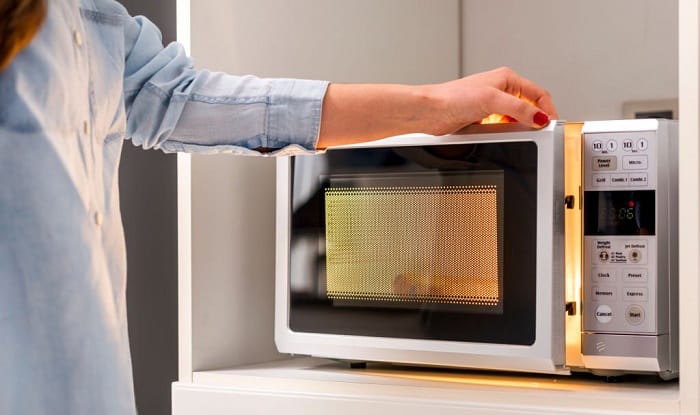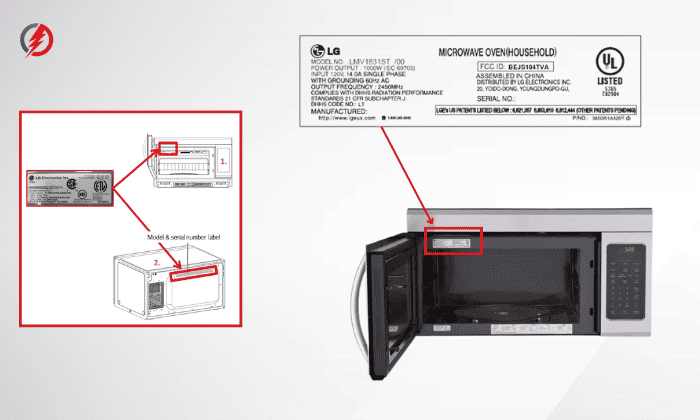It’s well worth knowing the answer to “How many amps does a microwave use?”, especially if you’re trying to size the breaker that will serve it or want to know how efficient it is. The best, first step to take is to look at how many watts it has.
Since most modern microwaves are rated in watts via the nameplate, refer to the values reflected there. Once you acquire the precise output wattage, use the formula: I (amps) = P (watts) / V (volts). Otherwise, use an ammeter or multimeter.
For example, if you have a normal wattage microwave ranging between 600 to 1,200-watt running at 120V, it will pull 5 to 10A.
Read on for a more detailed explanation and to know other considerations and ways to know microwave amp draw.
Table of Contents
How to Calculate Microwave Amp Usage?
Given the formula for current (I = P / V) and assuming the voltage is 110V, here are the different amperages of the common microwave products available:
\[ I (\text{amps}) = \frac{P (\text{watts})}{V (\text{volts})} \]
For example, a 1000-watt unit running at 110V will pull:
\[ I (\text{amps}) = \frac{1000 (\text{W})}{110 (\text{V})} = 9.1 (\text{A})\]
- A 1500 watt microwave pulls 13.6A.
- A 800W microwave draws 7.2A.
- A 900watt microwave uses 8.1A.
1. Look at the Nameplate
Usually, you only need to check the appliance’s nameplate first to see its amp rating. As you can see from this LG microwave, for example, it’s rated for 11A with a power output of 1,200W. We’re going to assume it’s a 110V device because 1200W / 110V = 10.9A (11A rounded off).
That power still falls within the normal wattage for microwave products in the US, which ranges between 600W to 1,200W. Larger models have outputs that can reach over 1,600W.
Since most products readily display their wattage (i.e. energy consumption) in listings, you shouldn’t have a hard time calculating the amps for a microwave, assuming it’s not readily visible.
With such a fairly small variation in wattage among microwaves, it’s not surprising that many are served by 15A or 20A breakers, with all other gadgets and fixtures in the same circuit considered (although it’s advisable to give the microwave its own circuit).
Overall, microwaves draw comparatively less power compared to portable spas, clothes dryers, and heaters.
If the microwave oven amperage and output wattage aren’t in the nameplate, you can check the manual. You should also try double-checking your microwave’s exterior and interior parts.
2. Contact the Manufacturer Directly
If you can’t read the nameplate or label anymore or it’s just not available (which makes the product highly dubious), don’t hesitate to reach out to the manufacturer for the information.
Try looking for a digital version of the manual on the official website, assuming they have separate online resources that can be downloaded. All the better if they allow you to input your microwave’s precise model and give you the exact manual.
Now, let’s assume you already saw the required electrical information on the nameplate. However, you also found out that two kinds of wattage are included in it: output and input. What now?
3. Use an Ammeter or Multimeter
Another step you can take is to use an ammeter. To me, overall, this is the best way because you’ll be able to measure the microwave’s actual current. Digital multimeters and clamp meters will suffice as well.
If you have an ammeter on hand and are wondering how to use it, you can begin by watching the following video tutorial:
You can, more or less, confirm or disprove the calculations we made here. On the whole, I wouldn’t be surprised if there are deviations due to the other points I’ll make below.
Regarding Input Wattage and Possible Excess Power Draws
If you really want to know the exact answer to “How many amps does a microwave pull?” and discover its “true” power draw, you sometimes need to go beyond the output wattage. As such, we need to know the difference between input wattage and power output.
- The power output or output wattage refers to the energy required by the microwave to heat its content.
- The input wattage, on the other hand, reflects the total amount of watts it uses to generate the said energy.
This is why you shouldn’t be surprised, once you consult an expert electrical engineer about the actual amperage of microwave, they’ll say to you that the amps should be figured from the input wattage rather than the power output.
Oftentimes, the input power is 1.5x or even 2x the latter.
On the whole, it’s well worth knowing, especially if you want to figure out your true microwave power usage and are trying to size its breaker.
Nonetheless, most of the time, you only need to be mindful of the microwave’s cooking power (i.e. the power output or output wattage), especially if you’re just trying to get an idea of the wattage it runs in while fulfilling its main purpose of heating your meals or snacks.
What’s certain is that you shouldn’t expect a microwave to stay on or under its power rating due to differences in efficiency.
- A 1,000W microwave may actually need 1,600 watts to get the job done. That’s 13.3A at 120V.
- A 1,200W one may actually fluctuate between 1,600W to 1800W because it only performs at 70% efficiency or may need to draw more power when at full capacity. That amounts, at most, to exactly 15A with the same voltage as above.
Taking note of these fluctuating wattages and NEC’s 80% electrical load rule on every circuit is crucial when sizing a breaker for your microwave. After all, you may end up with a small-sized breaker that will only trip once the microwave starts drawing more power than its rating. Check out these tips to fix it now:
- Reasons why your circuit breaker trip when the microwave door opens.
- 5 reasons why your GE microwave keeps tripping the breaker.
Conclusion
I hope I’ve helped you become more aware of the various factors influencing the answer to the query, “How many amps does a microwave use?” Here’s a summary of the points above:
- Stick to the information on the nameplate. If the rated amperage and watts are stated there, they should suffice.
- To see the real picture or confirm (or debunk) your calculations, use an ammeter.
- Consider input wattage and overall efficiency when sizing your microwave’s breaker.
- Take the most hassle-free route by ringing up, texting, or emailing the manufacturer for the information you need.

I am Edwin Jones, in charge of designing content for Galvinpower. I aspire to use my experiences in marketing to create reliable and necessary information to help our readers. It has been fun to work with Andrew and apply his incredible knowledge to our content.



